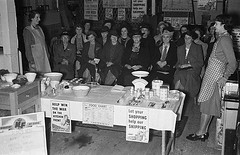
Keep calm and carry on cooking
It was the best of times, it was the worst of times, as rationing brought both misery and creativity to wartime Britain’s kitchens.
The average 1940’s shopping list was one of sheer sparsity: one fresh egg, 56g (2 oz) butter, 56g (2 oz) tea, 28g (1 oz) cheese, 225g (8 oz) sugar, 4 rashers of bacon, and 115g (4 oz) margarine. Rationing’s introduction was brought in to avoid civil unrest and curb demand on British produce since imported food was out of the question. But the introduction of rationing left housewives with minimal resources to feed their families, and so it demanded new and inspired ways of cooking – both to keep food interesting and make the little go far.
The government-led Ministry of Food was tasked with helping the cause. It combed through history to source recipes that would be suitable for rationed cooking, or for ways to store food (hay boxes were brought back in to popular use, for example). These recipes and ideas were promoted in leaflets, during radio programmes and in books published by the likes of Good Housekeeping and the Daily Telegraph. The Ministry also encouraged people to write in and share recipes and tips, which surfaced some true cooking ingenuity.
Cook and Food Historian, Monica Askay says: “The Ministry of Food books and radio programmes were full of ideas on how to cope with making recipes when you couldn’t get hold of as much sugar, fat or eggs. So it modified the recipes that people were used to.”
A trend for “mock” recipes crept in. Where a creative cook lurked, there would be no shortages. Mock cream, for example, consisted of creamed margarine and sugar, and dried milk powder. Or there was mock marzipan, which contained margarine, water, semolina, almond essence and sugar. Monica says that in time, it became less about how the recipe tasted and more about the appearance or texture they could create. Mock crab, a mix of egg (or dried egg), margarine, cheese, salad dressing, vinegar, salt and pepper, is another of Monica’s example. The vinegar curdled the eggs to give that crab-like texture. “People found that if they hadn’t eaten the real thing for 10 years, they didn’t like it as much as the mock recipe,” she says.

As well as the Ministry of Food, companies like Stork published recipe books to make the best of wartime rationing. Credit: Stork
Understandably, families didn’t want to be denied treats, so they pursued baking despite the lack of eggs, sugar and fat. Putting creative cooking to use, more fat could be created by boiling a ham bone, making a soup, leaving it to go cold and scraping the fat from the top. Into cakes it would go. Cooking help was at hand not only from the Ministry, but from companies like Stork, with its Stork Margarine Cookery Service, or the McDougalls Wartime Rationing Book. Stork’s books included How to Save Your Dinner (about cooking in emergencies and what to do in the event of an air raid warning), All About Buns and Scones, and Clock Wise Cooking.
Of course where there’s scarcity, a black market will surface, and the Second World War was no different. Sharply-dressed spivs (suspected persons and itinerant vagrants) would sell on street corners to those who could afford it. Meat, which was in such short supply, was an active black market product, and a prime target at major docks. In 1941, over 2,000 beef and lamb carcasses were stolen, prompting outcry from civilians for greater punishments for those involved in black market trade.
Rationing didn’t end until 1954 – a major disappointment to civilians who thought everything would return to normal as soon as the war was over. But it’s a period hailed as Britain’s most healthy, not only because people couldn’t eat to excess, but because those who’d previously not had access to a healthy diet were able to do so. Once rationing ended, however, there was a major reaction to the availability of food, with many overcompensating for the endless possibilities. “It didn’t matter how it tasted,” says Monica. “For example, one women’s magazine featured a grapefruit, cut in a zig-zag around the edge with crumbled peppermint cream on top, to be served as a starter. Suddenly everyone had all these ingredients and didn’t know what to do with them.”
Austerity breeds learning, experimentation and sharing, and there’s much to be taken from wartime cooking. It represents an era of creativity, and many cookbooks of the time have since been republished. But the’yre not just historic; they stand to inspire us in a way we might never have thought still relevant.






